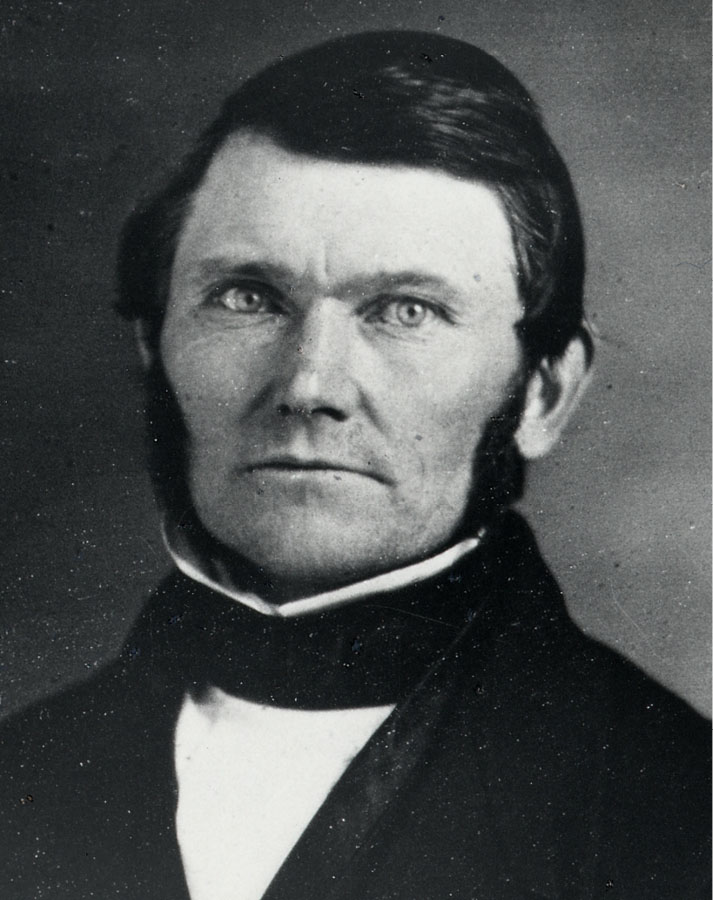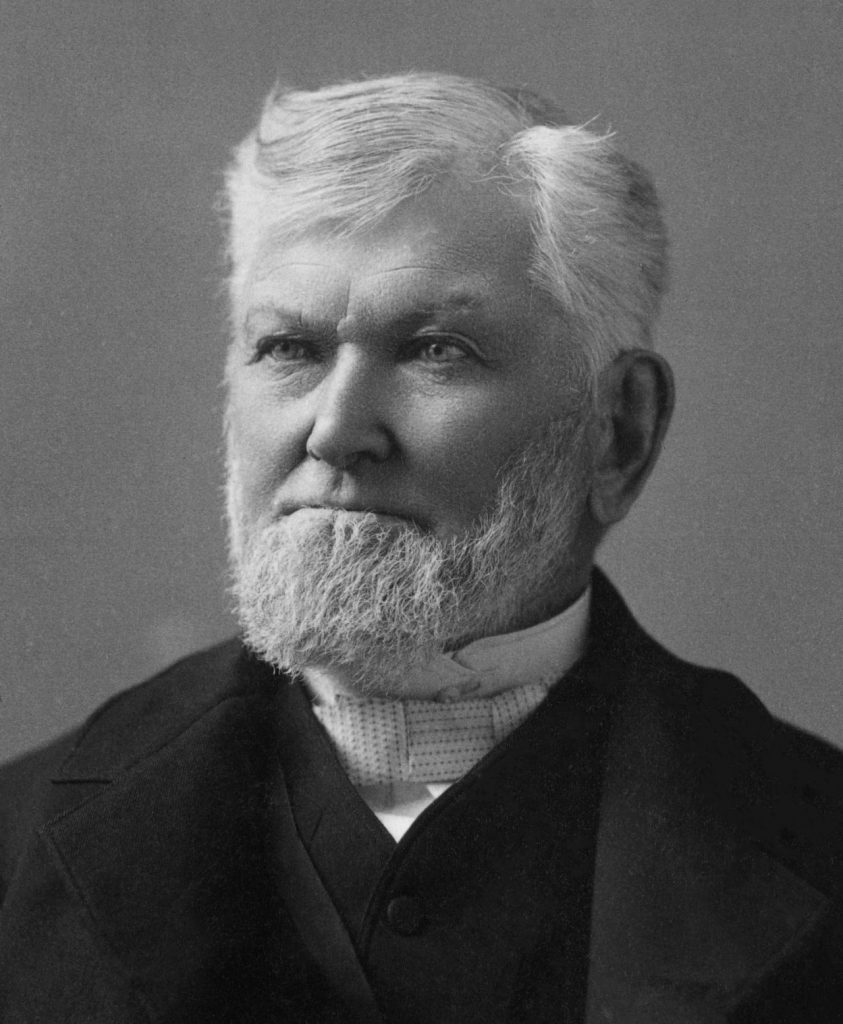Wilford Woodruff
(1807-1898)






D&C 118:6; 124:129; 136:13; 138:53; Official Declaration 1
By Susan Easton Black
“I have been numbered with those who are apparently the marked victims of misfortunes,” said Wilford Woodruff of his childhood. “It has seemed to me at times as though some invisible power were watching my footsteps in search of an opportunity to destroy my life.”1 Yet as he pondered the number of mishaps that had occurred beyond his childhood days, he said, “The repeated deliverances from all these remarkable dangers I ascribe to the mercies of my Heavenly Father.”2
In his youth, Wilford was religiously inclined, but he did not profess a particular religion. He remembered reading the scriptures and kneeling in “earnest prayer before God day and night as far as I could. … I had pleaded with the Lord many hours in the forest, among the rocks, and in the fields, and in the mill—often at midnight for light and truth and for His Spirit to guide me in the way of salvation.”3 After listening to the message of the Restoration preached by Zera Pulsipher, Wilford wrote, “The spirit bore witness of its truth.” He was baptized on December 31, 1833. Of his baptism, he penned, “The snow was about three feet deep, the day was cold, and the water was mixed with ice and snow, yet I did not feel the cold.”4
Four months after entering baptismal waters, Wilford moved to Kirtland, Ohio. Within days of his arrival at Kirtland, he learned that the Prophet Joseph Smith was looking for recruits for Zion’s Camp. He was among the first to volunteer. After marching with Zion’s Camp to Missouri, he served a mission to Arkansas, Tennessee, and Kentucky. Upon his return to Kirtland, he was ordained to the priesthood office of seventy on May 31, 1836.
On April 15, 1837, he was privileged to receive a patriarchal blessing from Joseph Smith Sr. In the blessing, he was told to share the gospel with his father’s household. Within a month of the blessing, Wilford was on his way to the East to share the gospel with his family. On that mission, he not only baptized family members but helped organize a branch of the Church in the Fox Islands. It was while he was serving in the Fox Islands that he received word of his call to the Quorum of the Twelve Apostles (see D&C 118:6). He was ordained an apostle on April 26, 1839, at the temple site in Far West, Missouri.
His first assignment as an apostle was to serve a mission to England. His mission was an overwhelming success. He wrote, “Through the blessings of God [I brought] over eighteen hundred souls” into baptismal waters during an eight month period.5 In 1844 he was given an opportunity to serve a mission in the eastern states. While on that mission, he received word that the Prophet Joseph had been murdered.
The next mission for Wilford was back to England as president of the British Mission. After two years in the British Isles, he returned to the United States and joined the Latter-day Saint exodus from Nauvoo to the Territory of Iowa. From Iowa, he journeyed with Brigham Young’s pioneer company across the plains to the Rocky Mountains.
Wilford spent much of his time in the Rockies as a companion to Brigham Young. “Some day,” said Brigham to him, “I shall look to you for my journal.”6 Of his journal writing, Wilford said, “I seem to be a marked victim of the adversary. I can find but one reason for this: the devil knew if I got into the Church of Jesus Christ of Latter-day Saints, I would write the history of that Church and leave on record the works and teachings of the prophets, of the apostles and elders.”7
At the April 1889 general conference, Wilford was sustained as president of The Church of Jesus Christ of Latter-day Saints. He said, “It is a position I have never looked for. … I pray God to give me grace equal to my day. … I pray God … to protect me and give me power to magnify my calling to the end of my days.”8 Difficult days followed for Wilford as government sanctions against the practice of plural marriage increased. Following much prayer and supplication to the Lord, on October 6, 1890, Wilford had the Plural Marriage Manifesto read to the Latter-day Saints assembled in the Tabernacle (Official Declaration 1). He said on that occasion, “I want to say to all Israel that the step which I have taken in issuing this Manifesto has not been done without earnest prayer before the Lord.”9
Towards the end of his life, Wilford summarized his journals and concluded from 1834 to 1895—
he traveled 172,269 miles, held 7,555 meetings, attended 75 semi-annual general conferences of the Church and 344 quarterly conferences, preached 3,526 discourses, established seventy-seven preaching places in missions, organized fifty-one branches, received 18,977 letters, written 11,519 letters, assisted in confirming 8,952 Saints, labored 603 days in the Endowment House, traveled through England, Scotland, Wales, six islands of the sea, and twenty-three states and five U.S. territories in the cause of righteousness.10
Wilford died on September 2, 1898, in San Francisco. He was buried six days later on September 8, 1898, in Salt Lake City.
1. Matthias F Cowley, Wilford Woodruff, History of His Life and Labors (Salt Lake City: Bookcraft, 1964), 5.
2. Cowley, Wilford Woodruff, 11.
3. Cowley, Wilford Woodruff, 18.
4. Cowley, Wilford Woodruff, 33–34.
5. Cowley, Wilford Woodruff, 109–110, 119.
6. Cowley, Wilford Woodruff, 346–47.
7. Cowley, Wilford Woodruff, 477.
8. Cowley, Wilford Woodruff, 560, 565.
9. Cowley, Wilford Woodruff, 570.
10. Andrew Jenson, LDS Biographical Encyclopedia, 4 vols. (Salt Lake City: Andrew Jenson History Company, 1901) 1:26.
Additional Resources
- Biography of Wilford Woodruff (josephsmithpapers.org)
